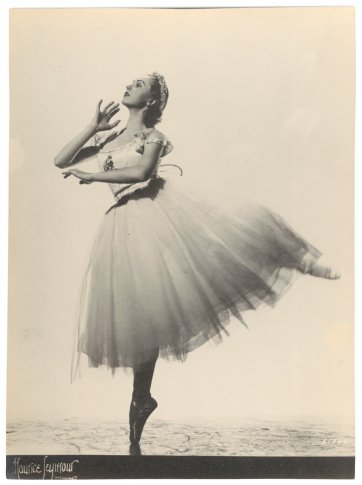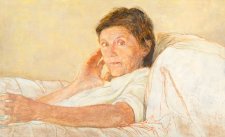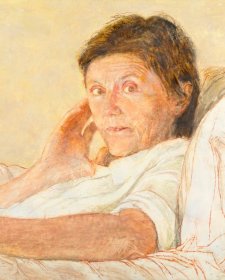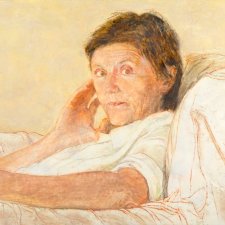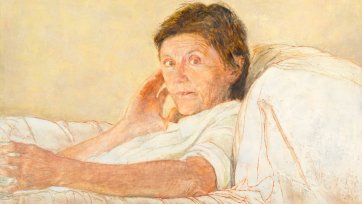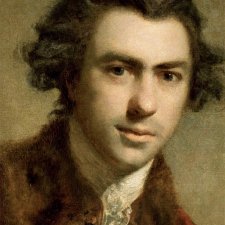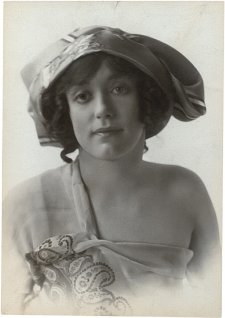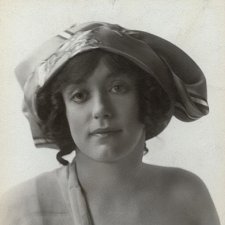It is customary to make the face of the sitter the centre of a portrait. Jenny Sages teases the viewer expecting such a convention by audaciously allowing the back of a young dancer’s head to dominate the composition of her Portrait of Irina Baranova (handing on the baton) 2007.
Irina Baranova was a principal dancer with the Ballet Russe de Monte Carlo, the famous company that was formed from the remnants of Sergei Diaghilev’s Ballet Russes after his death in 1929. She wasn’t part of the tour of Australian cities in 1936-1937, preferring to stay with artistic director Colonel de Basil for an American leg. When differences split the troupe, the name Ballet Russe de Monte Carlo stayed with choreographer Leonide Massine. De Basil named his group the Original Ballet Russes and organised a second tour of Australia in 1939–1940, this time taking Baranova with him. ‘The audiences were absolutely mad about us, we had enormous success and the people were so hospitable and friendly’ she later recalled.
Baranova had been one of the original ‘baby ballerinas’, as the press had affectionately dubbed them when she and two other teen-aged dancers were hired by George Balanchine in 1931. Escaping the Russian revolution, Baranova and her family had left Petrograd (where she was born) to live first in Bucharest then, like so many White Russians, in Paris. It was there that Balanchine had discovered her. At just twelve years old, she was dancing with such giants as Léonide Massine and Michel Fokine; by the time she was fourteen the young star was dancing leading roles and topping the bill. Her skill and extreme youth yielded a marketing coup for the company, capturing the imagination of the press and public alike.
On her Australian tour, Baranova performed in Les Sylphides, Les Presages and Aurora’s Wedding, among other ballets. Afterward, she left De Basil to join the Ballet Theatre (now American Ballet Theatre), staring in the last of Fokine’s ballets, Bluebeard (1941). She appeared as a ballerina in the films Florian (1940) and Yolanda (1943) but had effectively stopped dancing by 1945. The following year, she married the British theatrical agent Cecil Tennant, and she raised a family in England. Her eldest daughter, Victoria Tennant, became a film star in the US and her youngest, Irina, moved to Australia. Upon turning 80, Baranova moved to Byron Bay to be closer to her daughter and grandchildren.
Artist Jenny Sages explains that her portrait shows Baranova at the Melbourne headquarters of the Australian Ballet, where she was advising young artists on three ballets that were given to her long ago, including Le Spectre de la Rose, choreographed by Michel Fokine. Sages didn’t paint it through a series of staged sittings. Rather, she describes her process as ‘stalking her subject’, generating the portrait through a series of visits that familiarised the artist with the sitter’s personality, mannerisms and surroundings, as well as drawings and photographs. ‘Back in my studio I did drawing after drawing to put together in some way what I felt about the experience’, she explains. The process ‘culminated in a vine charcoal drawing on lovely waxy paper which I used as a study to do the final oil painting on an encaustic surface.’
Sages became very close to the dancer and her family over the course of the creation of the portrait, in which Baranova literally ‘hands on the baton’ – a pun on the conductor’s baton and the baton a runner transfers in a relay race. She recalls that when Irina died quietly at the age of 89, she was farewelled on a hilltop by her family and friends from the ballet world, with loving anecdotes, laughter and champagne, and a classical trio playing ‘The Dying Swan’.
